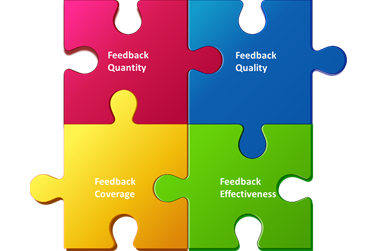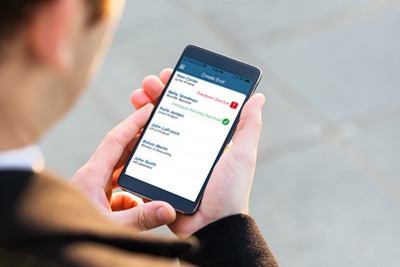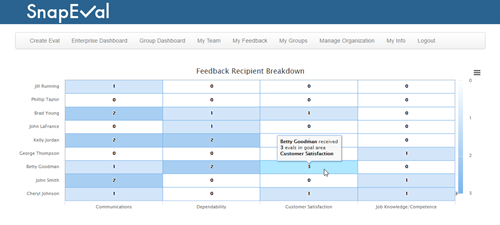
Many organizations of all sizes are considering augmenting or replacing traditional annual performance reviews with more continuous feedback management for their employees. The term that is rapidly gaining popularity for this new approach is ‘Continuous Performance Management.’
View This Blog as a Video
The cornerstone of any successful Continuous Feedback Management solution is frequent manager-employee ‘check-in’ meetings, where goals and performance are discussed.
The frequency of the check-in meetings varies depending on the organization, but examples include weekly, bi-weekly and ‘as requested’ by the manager or employee.

The benefits of these frequent check-in meetings have been widely documented to include:
- Increasing employee engagement and performance
- Satisfying millennials’ desire for frequent feedback
- Improving organizational agility.
For check-in meetings to be effective, it is essential that both the manager and employee are prepared to discuss the employee’s goals and detailed feedback about the employee’s performance.
Goals: An employee’s goals can include any mix of corporate goals and values, department goals, job function goals, team goals, and individual goals. Corporate goals and values, department goals, and job function goals tend to be long-term and typically don’t vary over the course of a year. Team and individual goals may include both long-term and short-term goals, such as a specific project or career development objective. Goals may be weighted differently depending on their importance to the organization. All goals and values should be documented and accessible to the employee at any time. They should be well understood by the employee through ongoing conversations with the manager.

There are four essential components for managers’ feedback in an effective Continuous Feedback Management solution:
- Feedback Quantity
- Feedback Quality
- Feedback Effectiveness
- Feedback Coverage
Let’s look at each of these components and how managers can achieve them.
Feedback Quantity: It’s important that a sufficient quantity of feedback is captured by the manager for the employee to make the check-in meetings worthwhile for both participants.
Realistically, most managers don’t have time to write detailed performance feedback reports in preparation for check-in meetings. If it isn’t quick and easy for a manager to capture feedback whenever it’s convenient, it simply won’t happen.
A state-of-the-art Continuous Feedback Management solution maximizes the quantity of feedback that managers document by enabling it to be captured instantly in ‘snapshots,’ at any place or time. Each performance feedback ‘snapshot’ includes a goal area or value, an achievement level, and a brief text note with feedback details.
Feedback snapshots can be captured with a mobile app on a smartphone, or with any web-enabled device with an internet connection, such as a tablet or laptop. The mobile app supports voice recognition to minimize typing and allows feedback to be captured even if the smartphone is offline, so feedback can be captured instantly at any time and at any place!
By enabling feedback to be captured quickly, at the time that it’s observed or thought of, it’s most accurate and isn’t forgotten.

Feedback Quality: To ensure that the quality of the captured feedback is maximized, sometimes expert advice is required to coach managers about the most effective ways to compose feedback or deliver it to an employee. This can be especially true for developmental feedback. This coaching should occur proactively, before the feedback is shared with the employee.
No Continuous Feedback Management system offering ‘canned’ advice to managers about effective performance feedback can approach the expertise, organizational awareness, and cultural sensitivity that an organization’s own HR Professional can offer.
A state-of-the-art Continuous Feedback Management solution engages an organization’s own HR Professional by automatically queuing feedback for their review, editing, and approval or rejection. This allows the HR Professional to proactively coach managers with expert advice when necessary. The manager can only share the feedback with the employee after it has been released from the queue by an HR Professional.
To minimize administrative overhead, criteria for queuing the feedback can be specified by the organization’s HR Professional. Example criteria could include the identity of the feedback recipient or creator, the feedback achievement level, or the content of the feedback text note. This assures that an HR Professional is only required to review feedback that has the potential to be problematic.
Feedback Effectiveness: In addition to aligning feedback with the employee’s goals, the effectiveness of the feedback for the employee can also be maximized by enabling managers to control the time and method that is used to share feedback with the employee.
For example, sometimes it’s most effective to share feedback immediately with the employee, such as a quick acknowledgement or thank you. Other times, it’s most effective to defer sharing to a future check-in meeting, when complex or developmental feedback can be discussed.

Many ‘real-time feedback’ products always share feedback instantly with the employee when it’s captured.
A state-of-the-art Continuous Feedback Management solution enables the manager to instantly share the feedback or defer sharing it to a future point in time, with the flip of a single switch.
Feedback Coverage: Performance feedback is captured in individual snapshots that cover a single goal area or value. Over time, it is important for managers to capture feedback snapshots across all goal areas and values for each employee. Like assembling individual photographs into a photo album, feedback snapshots form a comprehensive, accurate assessment of each employee’s performance.
A state-of-the-art Continuous Feedback Management solution includes administrative dashboards and provides a comprehensive view of feedback performance levels and trends. At a glance, heatmaps enable HR Professionals and Managers to ensure that each employee is receiving feedback across all goal areas. In SnapEval, all four components work together to provide a complete, state-of-the-art Continuous Feedback Management solution.
Now that you know more about SnapEval, why not sign up for a FREE account for your team?
I’m David Yeaple, VP of Business Development and Product Management at SnapEval, LLC. I’d love to get your feedback about this blog, our products, or anything else related to employee performance management. You can reach me at dyeaple@SnapEval.com or +1 585-414-5000.

